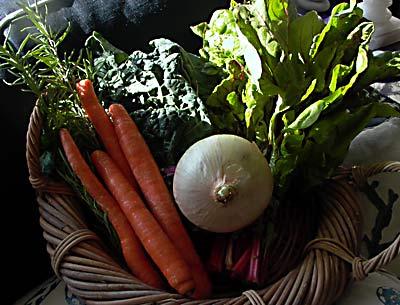Seasons by the Sea: A Big Pot of Delicious

This is the time of year when soups are on my mind. And my stove. On a recent trip to High Falls, N.Y., to visit our friend Nancy at her bed-and-breakfast, she prepared a ribollita. It was so delicious we had it two days in a row and I begged her for the recipe. I have made it twice since then.
Ribollita is an Italian soup/stew full of tomatoes, and beans and herbs and more vegetables and lots of kale. I made a huge batch on New Year’s Day, then toodled off to a party at Cindy and Jimmy’s. Cindy trumped me, for sure. She had made a big pot of Ina Garten’s corn chowder with some sweet corn from Pike’s she had frozen at the end of summer. It was a perfect, rich, and warming meal for the guests who had taken the polar bear plunge that day!
Soups have been around for as long as man could cook in a vessel over a fire. Just about every culture has some form of soup. The French have perfected the delicate and refined soups such as consommés, bouillons, and bisques. Japanese soups are light, elegant, and healthy. Thai soups tend to be gutsy with coconut milk, fish, and fresh green chilies.
The modern restaurant industry is said to be based on soup. Restoratifs (where the word restaurant comes from), were the first items served in public restaurants in 18th-century Paris. The word soup derives from sop or sup, meaning a slice of bread upon which the soup or broth is poured.
Advancements in science enabled soups to take many forms: portable, canned, dehydrated, and eventually microwavable. The earliest portable and dehydrated soups were used for the military, covered wagon trains, and cowboy chuck wagons. Eventually, they became a convenience for the home pantry.
Every cuisine has its own soups, and virtually any braised, sauced, or stewed dish can be made into soup simply by adding more liquid to the solids. Just about any combination of vegetables can be used, as long as you add a member of the allium family such as garlic, onions, or leeks. You can add backbone and more flavor by the addition of meat; cured pork products are particularly good when combined with bean or lentil soups. Sautéing or roasting vegetables enhances the flavor more than just boiling them.
James Peterson, the awesome author of numerous encyclopedic single-subject cookbooks, describes his basic formula for all chicken soups. From this method you can then take off in any ethnic direction. Cook a quartered chicken in a sauté pan with a bit of butter or oil. Remove from pan when done, drain off fat, then sweat your aromatic vegetables in the same pan. This combination is known as sofrito in Italy, mirepoix in France, and sofriget in Catalan cooking. It is usually a mixture of garlic and/or onions, carrots, celery, and herbs. Add broth to the vegetables, shred your chicken and add it back to the soup. You could add capers and olives to make a puttanesca-style soup, raisins and apricots to echo a Moroccan tagine, cilantro and toasted tortilla strips for a Mexican accent, and so forth.
There are also many methods for thickening soups other than using flour and cream. You can toast rice, grind it, then simmer it with the other ingredients. Soups can be a complete meal, along with a nice salad and some crusty bread. A homemade cream of tomato soup is always a hit with children, as are any soups with alphabet pasta. Vegetarians and vegans can be sated with any number of vegetable or mushroom broth-based soups, such as Nancy’s ribollita coming up.
Another plus: Soups are a one-pot meal. There’s less cleaning up, and they are very economical, especially when simply based on beans and a variety of vegetables. So whether you attempt an ajiaco chicken soup from Colombia, a zurek sour rye soup from Poland, or any other soup from the alphabet and the world, I assure you that you will find it gratifying, healthy, and a comforting endeavor in the coming winter months.
Click for Recipes
